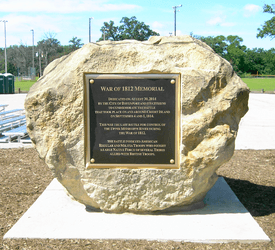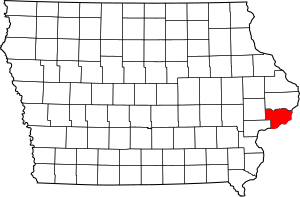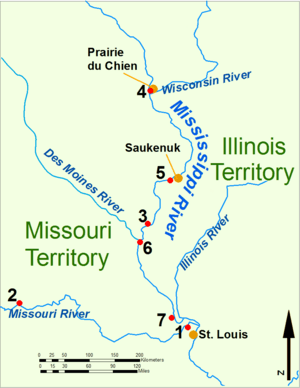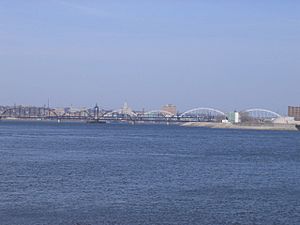Credit Island facts for kids
| Credit Island | |
|---|---|
Quick facts for kids 
War of 1812 Memorial on Credit Island
|
|
| Type | Public park |
| Location | Davenport, Scott County, Iowa, US |
| Area | 420-acre (1.7 km2) |
| Operated by | Davenport Parks and Recreation Department |
| Open | All year |
| Designated: | February 3, 1999 |
| Reference #: | 27 |


| Battle of Credit Island | |||||||
|---|---|---|---|---|---|---|---|
| Part of the War of 1812 | |||||||
|
|||||||
| Belligerents | |||||||
| Sauk |
|||||||
| Commanders and leaders | |||||||
| Black Hawk | |||||||
| Strength | |||||||
| 1,230 | 350 | ||||||
| Casualties and losses | |||||||
| None | 2 killed 11 wounded |
||||||
Credit Island is a cool island in the Mississippi River. You can find it on the southwest side of Davenport, Iowa, which is part of the Quad Cities area. The island got its name because it was once a trading post. People would trade animal furs and skins there. Sometimes, they would get "credit" (like a promise to pay later) for their goods, which is how the island got its unique name. Credit Island was added to the Davenport Register of Historic Properties on February 3, 1999, because of its important past.
Contents
Credit Island's Role in the War of 1812
Credit Island was the site of an important battle during the War of 1812. This battle, known as the Battle of Credit Island, happened on September 4–5, 1814. It was one of the westernmost battles of the war. Sauk warriors, supported by British forces, fought against a group of American soldiers led by Major Zachary Taylor.
Gathering Forces for Battle
Before the battle, both sides were getting ready. British Captain Thomas G. Anderson's journal tells us about the preparations. On August 27, 1814, a group of British and Native American warriors, including fifty Sioux and forty Fox (also called Renards), set off for the Rock River. They were preparing to meet the American forces. The British also sent a small team to check on an American gunboat that had sunk earlier.
The Battle Begins
American Major Taylor led over 350 U.S. soldiers and local fighters. Their goal was to help the soldiers at Prairie du Chien. On the evening of September 4, Taylor's group camped near the Rock River. That night, Black Hawk and his warriors attacked Taylor's guards, killing two American soldiers.
The next morning, as Taylor's men tried to land their boats, three British cannons opened fire. Under heavy attack, Taylor's forces had to retreat down the river. During this retreat, 11 more American soldiers were wounded.
Black Hawk's Story of the Fight
Black Hawk, a famous Sauk leader, shared his memories of the battle. He described a series of smaller fights around Credit Island and the river. He recalled seeing an American boat get stuck near the shore. His warriors quickly attacked it. They set the boat's sail on fire, and soon the whole boat was burning.
Another American boat came to rescue the people from the burning boat. Black Hawk's warriors fired at them, wounding the American leader. Later, another American boat also got stuck. Black Hawk ordered a charge, but the Americans fired back, killing two of his warriors. He admired how well this American leader managed to get his boat free and escape.
After the Americans left, Black Hawk's warriors put out the fire on the captured boat. They found supplies like clothing and guns, which they shared. They also found barrels of whiskey, which Black Hawk poured into the river, calling it "bad medicine." They then returned to their village, proudly flying the British flag.
Later, more American boats came up the river. Black Hawk and his warriors, with a British cannon, were ready. They fired at the boats, which quickly turned around and sailed away. The Americans eventually stopped further down the river to build a fort.
Credit Island Today
Today, Credit Island is a large, 420-acre (1.7 km2) public park. It's managed by the Davenport Parks and Recreation Department. It's a great place for outdoor activities! You can find a disc golf course, fields for rugby, soccer, baseball, and softball. There are also picnic areas, good spots for fishing, and a bike trail.
Credit Island hosts many public events and is a popular place for sightseeing. Many people also visit to watch eagles, especially in the colder months.
In May 2010, the city of Davenport received money to study the island's history through archaeology. In 2012, a new bridge was built on the west side of the island. This bridge connects the Mississippi River Trail bike path to Concord Street in Davenport. Sadly, the Credit Island Lodge caught fire in May 2013, but it was beautifully restored in 2015.
Other Names for Credit Island Through History
Credit Island has had a few different names over the years. Even though "Credit Island" has been its official name on government maps since the early days of Illinois becoming a state, people sometimes called it other things.
Offerman's Island: 1868 - 1903
Around 1868, a family named Offerman bought the island and renamed it Offerman's Island. John Offerman was still listed as the owner in 1894. Maps from the Mississippi River Commission in 1895 also showed it as Offerman's Island. Before the Offermans owned it, the island was also known as Suburban Island, Grand Island, and Manhattan Island. In 1901, the island was sold to Claus Kuehl. By 1903, it was renamed The Grand Isle.
Suburban Island: 1904 - 1918
In 1904, new private owners bought the island and called it Suburban Island. This name came from the railroad that went to the island. It became a fun place for swimming and sports before World War I.
During the 1890s, several amusement parks opened in the area. These included parks on Campbell's Island, Prospect Park, and Black Hawk State Park on the Illinois side. On the Iowa side, there were Suburban Island and Schutzen Park. Suburban Island even had a "Figure 8" roller coaster starting in 1905!
The city of Davenport bought the island in 1918. They held a contest to rename it, and "Credit Island" was the most popular choice. After the city bought it, a golf course eventually replaced the old picnic grounds and swimming areas.
See also
 In Spanish: Isla Credit para niños
In Spanish: Isla Credit para niños



